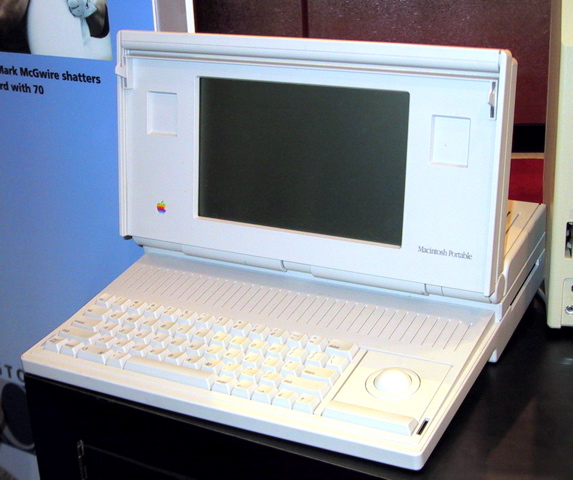The Macintosh Portable was introducted in 1989 and was designed to be just as powerful as a desktop Macintosh, but weighed a bulky 7.5 kilograms (17 lb) with a 12-hour battery life. After the Macintosh Portable, Apple introduced the PowerBook in 1991. The same year, Apple introduced System 7, a major upgrade to the operating system which added color to the interface and introduced new networking capabilities. It remained the architectural basis for Mac OS until 2001.

The success of the PowerBook and other products brought increasing revenue.For some time, Apple was doing incredibly well, introducing fresh new products and generating increasing profits in the process. The magazine MacAddict named the period between 1989 and 1991 as the "first golden age" of the Macintosh.
In 1990, Apple released the Macintosh LC with a singleexpansion slot for the Apple IIe Card to migrate Apple II users to the Macintosh platform.Apple stopped selling the Apple IIe in 1993.
Following the success of the Macintosh LC, Apple introduced the Centris line, a low-end Quadra offering, and the ill-fated Performa line that was sold with an overwhelming number of configurations and software bundles to avoid competing with the various consumer outlets such as Sears, Price Club, and Wal-Mart (the primary dealers for these models). Consumers ended up confused and did not understand the difference between models.
During this time Apple experimented with a number of other failed consumer targeted products including digital cameras, portable CD audio players, speakers, video consoles, and TV appliances. Enormous resources were also invested in the problem-plagued Newton division based on John Sculley's unrealistic market forecasts.Ultimately, none of these products helped, as Apple's market share and stock prices continued to slide.
Apple saw the Apple II series as too expensive to produce, while taking away sales from the low end Macintosh.
Microsoft continued to gain market share with Windows focusing on delivering software to cheap commodity personal computers while Apple was delivering a richly engineered, but expensive, experience.Apple relied on high profit margins and never developed a clear response. Instead, they sued Microsoft for using a graphical user interface similar to theApple Lisa in Apple Computer, Inc. v. Microsoft Corporation.The lawsuit dragged on for years before it was finally dismissed. At the same time, a series of major product flops and missed deadlines sullied Apple's reputation, and Sculley was replaced as CEO by Michael Spindler.
In 1994, Apple allied with IBM and Motorola in the AIM alliance. The goal was to create a new computing platform (the PowerPC Reference Platform), which would use IBM and Motorola hardware coupled with Apple's software. The AIM alliance hoped that PReP's performance and Apple's software would leave the PC far behind, thus countering Microsoft. The same year, Apple introduced the Power Macintosh, the first of many Apple computers to use Motorola's PowerPC processor.
In 1996, Michael Spindler was replaced by Gil Amelio as CEO. Gil Amelio made many changes at Apple, including extensive layoffs.After multiple failed attempts to improve Mac OS, first with the Taligent project, then later with Copland and Gershwin, Amelio chose to purchase NeXT and its NeXTSTEP operating system, bringing Steve Jobs back to Apple as an advisor.On July 9, 1997, Gil Amelio was ousted by the board of directors after overseeing a three-year record-low stock price and crippling financial losses. Jobs became the interim CEO and began restructuring the company's product line.
At the 1997 Macworld Expo, Steve Jobs announced that Apple would join Microsoft to release new versions of Microsoft Office for the Macintosh, and that Microsoft made a $150 million investment in non-voting Apple stock.
On November 10, 1997, Apple introduced the Apple Online Store, tied to a new build-to-order manufacturing strategy.
No comments:
Post a Comment